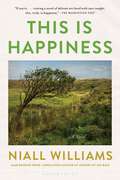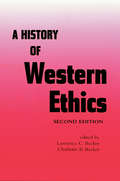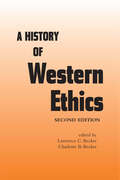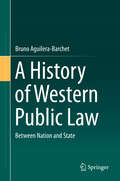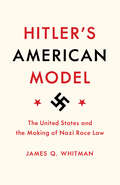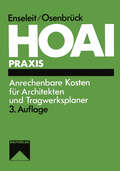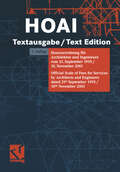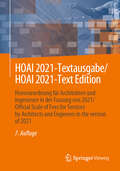- Table View
- List View
A History of the Laws of War: The Customs and Laws of War with Regards to Arms Control
by Alexander GillespieThis unique work of reference traces the origins of the modern laws of warfare from the earliest times to the present day. Relying on written records from as far back as 2400 BCE, and using sources ranging from the Bible to Security Council Resolutions, the author pieces together the history of a subject which is almost as old as civilisation itself. The author shows that as long as humanity has been waging wars it has also been trying to find ways of legitimising different forms of combatants and ascribing rules to them, protecting civilians who are either inadvertently or intentionally caught up between them, and controlling the use of particular classes of weapons that may be used in times of conflict. Thus it is that this work is divided into three substantial parts: Volume 1 on the laws affecting combatants and captives; Volume 2 on civilians; and Volume 3 on the law of arms control. This third volume deals with the question of the control of weaponry, from the Bronze Age to the Nuclear Age. In doing so, it divides into two parts: namely, conventional weapons and Weapons of Mass Destruction. The examination of the history of arms control of conventional weapons begins with the control of weaponry so that one side could achieve a military advantage over another. This pattern, which only began to change centuries after the advent of gunpowder, was later supplemented by ideals to control types of conventional weapons because their impacts upon opposing combatants were inhumane. By the late twentieth century, the concerns over inhumane conventional weapons were being supplemented by concerns over indiscriminate conventional weapons. The focus on indiscriminate weapons, when applied on a mass scale, is the core of the second part of the volume. Weapons of Mass Destruction are primarily weapons of the latter half of the twentieth century. Although both chemical and biological warfare have long historical lineages, it was only after the Second World War that technological developments meant that these weapons could be applied to cause large-scale damage to non-combatants. thi is unlike uclear weapons, which are a truly modern invention. Despite being the newest Weapon of Mass Destruction, they are also the weapon of which most international attention has been applied, although the frameworks by which they were contained in the last century, appear inadequate to address the needs of current times.As a work of reference this set of three books is unrivalled, and will be of immense benefit to scholars and practitioners researching and advising on the laws of warfare. It also tells a story which throws fascinating new light on the history of international law and on the history of warfare itself.
A History of the Laws of War: The Customs and Laws of War with Regards to Civilians in Times of Conflict
by Dr Alexander GillespieThis unique new work of reference traces the origins of the modern laws of warfare from the earliest times to the present day. Relying on written records from as far back as 2400 BCE, and using sources ranging from the Bible to Security Council Resolutions, the author pieces together the history of a subject which is almost as old as civilisation itself. The author shows that as long as humanity has been waging wars it has also been trying to find ways of legitimising different forms of combatants and ascribing rules to them, protecting civilians who are either inadvertently or intentionally caught up between them, and controlling the use of particular classes of weapons that may be used in times of conflict. Thus it is that this work is divided into three substantial parts: Volume 1 on the laws affecting combatants and captives; Volume 2 on civilians; and Volume 3 on the law of arms control. This second book on civilians examines four different topics. The first topic deals with the targetting of civilians in times of war. This discussion is one which has been largely governed by the developments of technologies which have allowed projectiles to be discharged over ever greater areas, and attempts to prevent their indiscriminate utilisation have struggled to keep pace. The second topic concerns the destruction of the natural environment, with particular regard to the utilisation of starvation as a method of warfare, and unlike the first topic, this one has rarely changed over thousands of years, although contemporary practices are beginning to represent a clear break from tradition. The third topic is concerned with the long-standing problems of civilians under the occupation of opposing military forces, where the practices of genocide, collective punishments and/or reprisals, and rape have occurred. The final topic in this volume is about the theft or destruction of the property of the enemy, in terms of either pillage or the intentional devastation of the cultural property of the opposition. As a work of reference this set of three books is unrivalled, and will be of immense benefit to scholars and practitioners researching and advising on the laws of warfare. It also tells a story which throws fascinating new light on the history of international law and on the history of warfare itself.
A History of the Protection of Regional Cultural Minorities in Europe: From the Edict of Nantes to the Present Day
by A. AlcockAntony Alcock recounts four stages in the history of regional cultural minority protection: protection of religious minorities and the rise of cultural nationalism before 1914; attempts to assimilate minorities between the wars together with the League of Nations' system of protection; neglect of the complex issues in minority protection after 1945, leading in many cases to violence; and finally the renaissance of cultural minorities in the west, while in the east the new states after the fall of communism have had difficulties in coming to terms with their minorities.
A History of the Royal Navy: The Seven Years War (A History of the Royal Navy)
by Martin RobsonThe Seven Years War (1756-1763) was the first global conflict and became the key factor in creating the British Empire. This book looks at Britain's maritime strategic, operational and tactical success (and failures), through a wide-ranging history of the Royal Navy's role in the war. By the end of the war in 1763 Britain was by no means a hegemonic power, but it was the only state capable of sustained global power projection on a global scale. Key to Britain's success was political and strategic direction from London, through the war planning of Pitt the Elder and the successful implementation of his policies by a stellar cast of naval and military leaders at an operational and tactical level. Martin Robson highlights the work of some of the key protagonists in the Royal Navy, such as Admiral Hawke whose appreciation of the wider strategic context at Quiberon Bay in 1759 decided the fate of North America. Robson ultimately shows that the creation, containment and expansion of the British Empire was made possible by the exercise of maritime power through the Royal Navy
A History of the Supreme Court
by the late Bernard SchwartzWhen the first Supreme Court convened in 1790, it was so ill-esteemed that its justices frequently resigned in favor of other pursuits. John Rutledge stepped down as Associate Justice to become a state judge in South Carolina; John Jay resigned as Chief Justice to run for Governor of New York; and Alexander Hamilton declined to replace Jay, pursuing a private law practice instead. As Bernard Schwartz shows in this landmark history, the Supreme Court has indeed travelled a long and interesting journey to its current preeminent place in American life. In A History of the Supreme Court, Schwartz provides the finest, most comprehensive one-volume narrative ever published of our highest court. With impeccable scholarship and a clear, engaging style, he tells the story of the justices and their jurisprudence--and the influence the Court has had on American politics and society. With a keen ability to explain complex legal issues for the nonspecialist, he takes us through both the great and the undistinguished Courts of our nation's history. He provides insight into our foremost justices, such as John Marshall (who established judicial review in Marbury v. Madison, an outstanding display of political calculation as well as fine jurisprudence), Roger Taney (whose legacy has been overshadowed by Dred Scott v. Sanford), Oliver Wendell Holmes, Louis Brandeis, Benjamin Cardozo, and others. He draws on evidence such as personal letters and interviews to show how the court has worked, weaving narrative details into deft discussions of the developments in constitutional law. Schwartz also examines the operations of the court: until 1935, it met in a small room under the Senate--so cramped that the judges had to put on their robes in full view of the spectators. But when the new building was finally opened, one justice called it "almost bombastically pretentious," and another asked, "What are we supposed to do, ride in on nine elephants?" He includes fascinating asides, on the debate in the first Court, for instance, over the use of English-style wigs and gowns (the decision: gowns, no wigs); and on the day Oliver Wendell Holmes announced his resignation--the same day that Earl Warren, as a California District Attorney, argued his first case before the Court. The author brings the story right up to the present day, offering balanced analyses of the pivotal Warren Court and the Rehnquist Court through 1992 (including, of course, the arrival of Clarence Thomas). In addition, he includes four special chapters on watershed cases: Dred Scott v. Sanford, Lochner v. New York, Brown v. Board of Education, and Roe v. Wade. Schwartz not only analyzes the impact of each of these epoch-making cases, he takes us behind the scenes, drawing on all available evidence to show how the justices debated the cases and how they settled on their opinions. Bernard Schwartz is one of the most highly regarded scholars of the Supreme Court, author of dozens of books on the law, and winner of the American Bar Association's Silver Gavel Award. In this remarkable account, he provides the definitive one-volume account of our nation's highest court.
A History of the Supreme Court
by the late Bernard SchwartzWhen the first Supreme Court convened in 1790, it was so ill-esteemed that its justices frequently resigned in favor of other pursuits. John Rutledge stepped down as Associate Justice to become a state judge in South Carolina; John Jay resigned as Chief Justice to run for Governor of New York; and Alexander Hamilton declined to replace Jay, pursuing a private law practice instead. As Bernard Schwartz shows in this landmark history, the Supreme Court has indeed travelled a long and interesting journey to its current preeminent place in American life. In A History of the Supreme Court, Schwartz provides the finest, most comprehensive one-volume narrative ever published of our highest court. With impeccable scholarship and a clear, engaging style, he tells the story of the justices and their jurisprudence--and the influence the Court has had on American politics and society. With a keen ability to explain complex legal issues for the nonspecialist, he takes us through both the great and the undistinguished Courts of our nation's history. He provides insight into our foremost justices, such as John Marshall (who established judicial review in Marbury v. Madison, an outstanding display of political calculation as well as fine jurisprudence), Roger Taney (whose legacy has been overshadowed by Dred Scott v. Sanford), Oliver Wendell Holmes, Louis Brandeis, Benjamin Cardozo, and others. He draws on evidence such as personal letters and interviews to show how the court has worked, weaving narrative details into deft discussions of the developments in constitutional law. Schwartz also examines the operations of the court: until 1935, it met in a small room under the Senate--so cramped that the judges had to put on their robes in full view of the spectators. But when the new building was finally opened, one justice called it "almost bombastically pretentious," and another asked, "What are we supposed to do, ride in on nine elephants?" He includes fascinating asides, on the debate in the first Court, for instance, over the use of English-style wigs and gowns (the decision: gowns, no wigs); and on the day Oliver Wendell Holmes announced his resignation--the same day that Earl Warren, as a California District Attorney, argued his first case before the Court. The author brings the story right up to the present day, offering balanced analyses of the pivotal Warren Court and the Rehnquist Court through 1992 (including, of course, the arrival of Clarence Thomas). In addition, he includes four special chapters on watershed cases: Dred Scott v. Sanford, Lochner v. New York, Brown v. Board of Education, and Roe v. Wade. Schwartz not only analyzes the impact of each of these epoch-making cases, he takes us behind the scenes, drawing on all available evidence to show how the justices debated the cases and how they settled on their opinions. Bernard Schwartz is one of the most highly regarded scholars of the Supreme Court, author of dozens of books on the law, and winner of the American Bar Association's Silver Gavel Award. In this remarkable account, he provides the definitive one-volume account of our nation's highest court.
The History of the Technology and Construction Court on Its 150th Anniversary: Rewriting the Rules
by Sir Peter Coulson And David SawtellThis collection marks the 150th anniversary of the Technology and Construction Court by presenting insights into its history and impact.The contributors are current and retired senior judges, renowned academics and leading construction and technology lawyers. The book draws on their different perspectives and approaches to showcase different aspects of the Official Referees and the TCC from its origins in the Judicature Act 1873 through to its modern-day role as an international leader in dispute resolution through litigation, arbitration and adjudication.Different essays consider the role of the TCC in procedural reform and the digital transformation of dispute resolution, building safety, and how it has impacted on doctrinal English law.The book also explores the lives and impact of notable Official Referees and TCC judges from the senior judiciary's perspective, with contributions by Lord Dyson on the transition from the Official Referees to the TCC, Sir Rupert Jackson on the Housing Grants, Construction and Regeneration Act 1996, Dame Finola O'Farrell on the TCC today, Sir Peter Coulson on Sir Brett Cloutman QC (a Senior Referee who was awarded a Victoria Cross) and Her Honour Frances Kirkham on the court's role in the regions.The creation of a specialist dispute resolution forum for complicated engineering, construction and technological disputes is a foundational milestone in the legal history of construction law in England and Wales. This collection offers a unique insight from the judiciary, practising lawyers and academics into the significance and development of the court.
History of the Yale Law School: The Tercentennial Lectures
by Prof. Anthony T. KronmanThe entity that became the Yale Law School started life early in the nineteenth century as a proprietary school, operated as a sideline by a couple of New Haven lawyers. The New Haven school affiliated with Yale in the 1820s, but it remained so frail that in 1845 and again in 1869 the University seriously considered closing it down. From these humble origins, the Yale Law School went on to become the most influential of American law schools. In the later nineteenth century the School instigated the multidisciplinary approach to law that has subsequently won nearly universal acceptance. In the 1930s the Yale Law School became the center of the jurisprudential movement known as legal realism, which has ever since shaped American law. In the second half of the twentieth century Yale brought the study of constitutional and international law to prominence, overcoming the emphasis on private law that had dominated American law schools. By the end of the twentieth century, Yale was widely acknowledged as the nation’s leading law school.The essays in this collection trace these notable developments. They originated as a lecture series convened to commemorate the tercentenary of Yale University. A distinguished group of scholars assembled to explore the history of the School from the earliest days down to modern times. This volume preserves the highly readable format of the original lectures, supported with full scholarly citations.Contributors to this volume are Robert W. Gordon, Laura Kalman, John H. Langbein, Gaddis Smith, and Robert Stevens, with an introduction by Anthony T. Kronman.
A History of Utilitarian Ethics: Studies in Private Motivation and Distributive Justice, 1700-1875 (Routledge Studies in the History of Economics)
by Samuel HollanderIn this landmark volume, Samuel Hollander presents a fresh and compelling history of moral philosophy from Locke to John Stuart Mill, showing that a ‘moral sense’ can actually be considered compatible with utilitarianism. The book also explores the link between utilitarianism and distributive justice. Hollander engages in close textual exegesis of the works relating to individual authors, while never losing sight of the intellectual relationships between them. Tying together the greatest of the British moral philosophers, this volume reveals an unexpected unity of eighteenth and nineteenth century ethical doctrine at both the individual and social level. Essential reading for advanced students and researchers of the history of economic thought, political economy, history of ethics, history of political thought and intellectual history.
A History of Utilitarian Ethics: Studies in Private Motivation and Distributive Justice, 1700-1875 (Routledge Studies in the History of Economics)
by Samuel HollanderIn this landmark volume, Samuel Hollander presents a fresh and compelling history of moral philosophy from Locke to John Stuart Mill, showing that a ‘moral sense’ can actually be considered compatible with utilitarianism. The book also explores the link between utilitarianism and distributive justice. Hollander engages in close textual exegesis of the works relating to individual authors, while never losing sight of the intellectual relationships between them. Tying together the greatest of the British moral philosophers, this volume reveals an unexpected unity of eighteenth and nineteenth century ethical doctrine at both the individual and social level. Essential reading for advanced students and researchers of the history of economic thought, political economy, history of ethics, history of political thought and intellectual history.
A History of Victims of Crime: How they Reclaimed their Rights (Routledge Contemporary Issues in Criminal Justice and Procedure)
by Stephen J. Strauss-WalshThis book examines the evolution of the contemporary crime victim’s procedural place within modern Western societies. Taking the history of the Irish crime victim as a case study, the work charts the place of victims within criminal justice over time. This evolves from the expansive latitude that they had during the eighteenth century, to their major relegation to witness and informer in the nineteenth, and back to a more contemporary recapturing of some of their previous centrality. The book also studies what this has meant for the position of suspects and offenders as well as the population more generally. Therefore, some analysis is devoted to examining its impact on an offender’s right to fair trial and social forms. It is held that the modern crime victim has transcended its position of marginality. This happened not only in law, but as the consequence of the victim’s new role as a key sociopolitical stakeholder. This work flags the importance of victim rights conferrals, and the social transformations that engendered such trends. In this way victim re-emergence is evidenced as being not just a legal change, but a consequence of several more recent sociocultural transformations in our societies. The book will be of interest to researchers, academics, and policy makers in criminal law, human rights law, criminology, and legal history.
A History of Victims of Crime: How they Reclaimed their Rights (Routledge Contemporary Issues in Criminal Justice and Procedure)
by Stephen J. Strauss-WalshThis book examines the evolution of the contemporary crime victim’s procedural place within modern Western societies. Taking the history of the Irish crime victim as a case study, the work charts the place of victims within criminal justice over time. This evolves from the expansive latitude that they had during the eighteenth century, to their major relegation to witness and informer in the nineteenth, and back to a more contemporary recapturing of some of their previous centrality. The book also studies what this has meant for the position of suspects and offenders as well as the population more generally. Therefore, some analysis is devoted to examining its impact on an offender’s right to fair trial and social forms. It is held that the modern crime victim has transcended its position of marginality. This happened not only in law, but as the consequence of the victim’s new role as a key sociopolitical stakeholder. This work flags the importance of victim rights conferrals, and the social transformations that engendered such trends. In this way victim re-emergence is evidenced as being not just a legal change, but a consequence of several more recent sociocultural transformations in our societies. The book will be of interest to researchers, academics, and policy makers in criminal law, human rights law, criminology, and legal history.
A History of Western Ethics
by Charlotte B. BeckerThis newly revised and updated edition of A History of Western Ethics is a coherent and accessible overview of the most important figures and influential ideas of the history of ethics in the Western philosophical tradition.
A History of Western Ethics
by Lawrence C. Becker Charlotte B. BeckerThis newly revised and updated edition of A History of Western Ethics is a coherent and accessible overview of the most important figures and influential ideas of the history of ethics in the Western philosophical tradition.
A History of Western Public Law: Between Nation and State
by Bruno Aguilera-BarchetThe book outlines the historical development of Public Law and the state from ancient times to the modern day, offering an account of relevant events in parallel with a general historical background, establishing and explaining the relationships between political, religious, and economic events.
Hitler's American Model: The United States and the Making of Nazi Race Law
by James Q. WhitmanHow American race law provided a blueprint for Nazi GermanyNazism triumphed in Germany during the high era of Jim Crow laws in the United States. Did the American regime of racial oppression in any way inspire the Nazis? The unsettling answer is yes. In Hitler's American Model, James Whitman presents a detailed investigation of the American impact on the notorious Nuremberg Laws, the centerpiece anti-Jewish legislation of the Nazi regime. Contrary to those who have insisted that there was no meaningful connection between American and German racial repression, Whitman demonstrates that the Nazis took a real, sustained, significant, and revealing interest in American race policies.As Whitman shows, the Nuremberg Laws were crafted in an atmosphere of considerable attention to the precedents American race laws had to offer. German praise for American practices, already found in Hitler's Mein Kampf, was continuous throughout the early 1930s, and the most radical Nazi lawyers were eager advocates of the use of American models. But while Jim Crow segregation was one aspect of American law that appealed to Nazi radicals, it was not the most consequential one. Rather, both American citizenship and antimiscegenation laws proved directly relevant to the two principal Nuremberg Laws—the Citizenship Law and the Blood Law. Whitman looks at the ultimate, ugly irony that when Nazis rejected American practices, it was sometimes not because they found them too enlightened, but too harsh.Indelibly linking American race laws to the shaping of Nazi policies in Germany, Hitler's American Model upends understandings of America's influence on racist practices in the wider world.
Hitler's American Model: The United States and the Making of Nazi Race Law
by James Q. WhitmanHow American race law provided a blueprint for Nazi GermanyNazism triumphed in Germany during the high era of Jim Crow laws in the United States. Did the American regime of racial oppression in any way inspire the Nazis? The unsettling answer is yes. In Hitler's American Model, James Whitman presents a detailed investigation of the American impact on the notorious Nuremberg Laws, the centerpiece anti-Jewish legislation of the Nazi regime. Contrary to those who have insisted that there was no meaningful connection between American and German racial repression, Whitman demonstrates that the Nazis took a real, sustained, significant, and revealing interest in American race policies.As Whitman shows, the Nuremberg Laws were crafted in an atmosphere of considerable attention to the precedents American race laws had to offer. German praise for American practices, already found in Hitler's Mein Kampf, was continuous throughout the early 1930s, and the most radical Nazi lawyers were eager advocates of the use of American models. But while Jim Crow segregation was one aspect of American law that appealed to Nazi radicals, it was not the most consequential one. Rather, both American citizenship and antimiscegenation laws proved directly relevant to the two principal Nuremberg Laws—the Citizenship Law and the Blood Law. Whitman looks at the ultimate, ugly irony that when Nazis rejected American practices, it was sometimes not because they found them too enlightened, but too harsh.Indelibly linking American race laws to the shaping of Nazi policies in Germany, Hitler's American Model upends understandings of America's influence on racist practices in the wider world.
HOAI: Wer darf was abrechnen? Was ist für wen anrechenbar? Mit einem ABC der anrechenbaren Kosten
by Dieter Enseleit Christoph BubertDiese erläuternde Darstellung der Kostenarten und deren Anrechenbarkeit hilft, Streitigkeiten bei der Honorarberechnung zu vermeiden. Der jeweilige Anwender - Architekt oder Tragwerksplaner sowie öffentlicher und privater Auftraggeber - kann anhand dieser praxisnahen Kommentierung leicht ablesen, welche Kosten für wen anrechenbar sind.
HOAI: Textausgabe/Text Edition
by B. S. I. Language Bsi Language ServicesFür ausländische Planer, die auf dem deutschen Markt tätig sind, gilt die HOAI ebenso wie für deutsche Architekten und Ingenieure. Diese zweisprachige Textausgabe in Deutsch und Englisch bietet englischsprachigen Auftraggebern und Auftragnehmern die Möglichkeiten, sich über dieses in Deutschland verbindliche Honorarregelwerk zu informieren. Die Honorartafeln sind in Euro angegeben und nach dem "Neunten Euro-Einführungsgesetz" aktualisiert.
HOAI 2009-Textausgabe/HOAI 2009-Text Edition: Honorarordnung für Architekten und Ingenieure vom 18. August 2009/Official Scale of Fees for Services by Architects and Engineers dated 18th August 2009
by Lowbudgettranslations. ComSeit der Öffnung des EU-Binnenmarktes sind ausländische Investoren und ausführende Firmen verstärkt auf dem deutschen Markt tätig. Umgekehrt möchten ausländische Auftraggeber wissen, nach welchen Bestimmungen ihr deutscher Architekt sein Honorar festlegt. Die 4. Auflage der zweisprachigen HOAI-Textausgabe wurde vollständig aktualisiert und überarbeitet, denn seit dem 18. August 2009 ist die neue HOAI in Kraft getreten. Im 1. Teil finden Sie die HOAI in deutscher Fassung, im 2. Teil die englische Übersetzung.
HOAI 2013: Praxisleitfaden für Ingenieure und Architekten
by Heinz SimmendingerMit der 7. Novelle der HOAI sind erneut umfangreiche Änderungen in der Honorarermittlung der Ingenieure und Architekten umgesetzt worden. Die Leistungsbilder wurden überarbeitet, den aktuellen Anforderungen angepasst und neue Grundleistungen aufgenommen. In diesem Zuge wurde auch die Bewertung der einzelnen Leistungsphasen angepasst. Darüber hinaus ist die Berücksichtigung der vorhandenen Bausubstanz wieder eingeführt und die Regelungen zum Umbauzuschlag erneut umgestellt worden. Das vorliegende Werk hilft bei der schnellstmöglichen Einarbeitung in die HOAI 2013. Neben einer praxisorientierten Einführung bietet es bewährte Arbeitshilfen sowie den kompletten aktuellen Verordnungstext.
HOAI 2013: Praxisleitfaden für Ingenieure und Architekten
by Heinz SimmendingerMit der 7. Novelle der HOAI sind erneut umfangreiche Änderungen in der Honorarermittlung der Ingenieure und Architekten umgesetzt worden. Die Leistungsbilder wurden überarbeitet, den aktuellen Anforderungen angepasst und neue Grundleistungen aufgenommen. In diesem Zuge wurde auch die Bewertung der einzelnen Leistungsphasen angepasst. Darüber hinaus ist die Berücksichtigung der vorhandenen Bausubstanz wieder eingeführt und die Regelungen zum Umbauzuschlag erneut umgestellt worden. Das vorliegende Werk hilft bei der schnellstmöglichen Einarbeitung in die HOAI 2013. Neben einer praxisorientierten Einführung bietet es bewährte Arbeitshilfen sowie den kompletten aktuellen Verordnungstext.
HOAI 2013-Textausgabe/HOAI 2013-Text Edition: Honorarordnung für Architekten und Ingenieure vom 10. Juli 2013/Official Scale of Fees for Services by Architects and Engineers dated July 10, 2013
by Springer Fachmedien WiesbadenSeit der Öffnung des EU-Binnenmarktes sind ausländische Investoren und ausführende Firmen verstärkt auf dem deutschen Markt tätig. Umgekehrt möchten ausländische Auftraggeber wissen, nach welchen Bestimmungen ihr deutscher Architekt sein Honorar festlegt. Die 6. Auflage der zweisprachigen HOAI-Textausgabe wurde grundlegend überarbeitet. Im 1. Teil finden Sie den Wortlaut der HOAI 2013 in deutscher Fassung, im 2. Teil die englische Übersetzung.
HOAI 2013-Textausgabe/HOAI 2013-Text Edition: Honorarordnung für Architekten und Ingenieure vom 10. Juli 2013/Official Scale of Fees for Services by Architects and Engineers dated July 10, 2013
by Springer Fachmedien WiesbadenSeit der Öffnung des EU-Binnenmarktes sind ausländische Investoren und ausführende Firmen verstärkt auf dem deutschen Markt tätig. Umgekehrt möchten ausländische Auftraggeber wissen, nach welchen Bestimmungen ihr deutscher Architekt sein Honorar festlegt. Die 5. Auflage der zweisprachigen HOAI-Textausgabe wurde anlässlich der HOAI Novelle 2013 vollständig aktualisiert und überarbeitet. Im 1. Teil finden Sie den Wortlaut der HOAI 2013 in deutscher Fassung, im 2. Teil die englische Übersetzung.
HOAI 2021-Textausgabe/HOAI 2021-Text Edition: Honorarordnung für Architekten und Ingenieure in der Fassung von 2021/Official Scale of Fees for Services by Architects and Engineers in the version of 2021
by Springer Fachmedien WiesbadenSeit der Öffnung des EU-Binnenmarktes sind ausländische Investoren und ausführende Firmen verstärkt auf dem deutschen Markt tätig. Umgekehrt möchten ausländische Auftraggeber wissen, nach welchen Bestimmungen ihr deutscher Architekt sein Honorar festlegt. Die 6. Auflage der zweisprachigen HOAI-Textausgabe wurde grundlegend überarbeitet. Im 1. Teil finden Sie den Wortlaut der HOAI 2021 in deutscher Fassung, im 2. Teil die englische Übersetzung.

